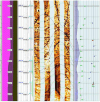Carbon Mineralization in Fractured Mafic and Ultramafic Rocks: A Review
- PMID: 39588264
- PMCID: PMC11586057
- DOI: 10.1029/2023RG000815
Carbon Mineralization in Fractured Mafic and Ultramafic Rocks: A Review
Abstract
Mineral carbon storage in mafic and ultramafic rock masses has the potential to be an effective and permanent mechanism to reduce anthropogenic CO2. Several successful pilot-scale projects have been carried out in basaltic rock (e.g., CarbFix, Wallula), demonstrating the potential for rapid CO2 sequestration. However, these tests have been limited to the injection of small quantities of CO2. Thus, the longevity and feasibility of long-term, large-scale mineralization operations to store the levels of CO2 needed to address the present climate crisis is unknown. Moreover, CO2 mineralization in ultramafic rocks, which tend to be more reactive but less permeable, has not yet been quantified. In these systems, fractures are expected to play a crucial role in the flow and reaction of CO2 within the rock mass and will influence the CO2 storage potential of the system. Therefore, consideration of fractures is imperative to the prediction of CO2 mineralization at a specific storage site. In this review, we highlight key takeaways, successes, and shortcomings of CO2 mineralization pilot tests that have been completed and are currently underway. Laboratory experiments, directed toward understanding the complex geochemical and geomechanical reactions that occur during CO2 mineralization in fractures, are also discussed. Experimental studies and their applicability to field sites are limited in time and scale. Many modeling techniques can be applied to bridge these limitations. We highlight current modeling advances and their potential applications for predicting CO2 mineralization in mafic and ultramafic rocks.
Keywords: CO2 storage; carbon mineralization; fractures; geochemistry; geomechanics; sequestration.
© 2024. The Author(s).
Conflict of interest statement
The authors declare no conflicts of interest relevant to this study.
Figures









References
-
- Adeoye, J. T. , Menefee, A. H. , Xiong, W. , Wells, R. K. , Skemer, P. , Giammar, D. E. , & Ellis, B. R. (2017). Effect of transport limitations and fluid properties on reaction products in fractures of unaltered and serpentinized basalt exposed to high PCO fluids. International Journal of Greenhouse Gas Control, 63, 310–320. 10.1016/j.ijggc.2017.06.003 - DOI
-
- Ahoulou, A. W. A. , Tinet, A.‐J. , Oltéan, C. , & Golfier, F. (2020). Experimental insights into the interplay between buoyancy, convection, and dissolution reaction. Journal of Geophysical Research: Solid Earth, 125(11), e2020JB020854. 10.1029/2020JB020854 - DOI
-
- Al‐Busaidi, A. , Hazzard, J. F. , & Young, R. P. (2005). Distinct element modeling of hydraulically fractured Lac du Bonnet granite. Journal of Geophysical Research, 110(B6), B06302. 10.1029/2004jb003297 - DOI
-
- Alfredsson, H. A. , Oelkers, E. H. , Hardarsson, B. S. , Franzson, H. , Gunnlaugsson, E. , & Gislason, S. R. (2013). The geology and water chemistry of the Hellisheidi, SW‐Iceland carbon storage site. International Journal of Greenhouse Gas Control, 12, 399–418. 10.1016/j.ijggc.2012.11.019 - DOI
-
- Aminu, M. D. , Nabavi, S. A. , Rochelle, C. A. , & Manovic, V. (2017). A review of developments in carbon dioxide storage. Applied Energy, 208, 1389–1419. 10.1016/j.apenergy.2017.09.015 - DOI
Publication types
LinkOut - more resources
Full Text Sources
